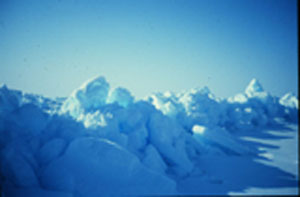Global warming to thaw Arctic ice and make polar bears migrate
The temperature of temperate latitudes of all continents in the northern hemisphere will rise by four or six degrees in 200 years
The Calculus Mathematics Institute of the Russian Academy of Sciences conducted a unique research of the climate change dynamics. Scientists modeled the development of the climate change on planet Earth during 19th-22nd centuries. It is the only Russian mathematical model to date, which takes account of the general circulation of the atmosphere and the ocean. 
The calculations were made on the supercomputer, which was installed in the Academy a year ago. The machine is capable of making 80 gigaflops (80 billion operations a second); it is based on two Hewlett-Packard Intel Itanium 2 processor units. When the new climate model was presented in Moscow, US President George W. Bush unveiled the new supercomputer of NASA, which was also based on Intel Itanium 2. The calculating ability of NASA computer systems increased ten times: the new computer puts out 42 teraflops – 42 trillion operations a second. The Russian know-how is about the combination of the latest processor unit and the unique software.
The director of the Calculus Mathematics Institute of the Russian Academy of Sciences, academician Valentin Dimnikov, said that scientists reconstructed the climate of the 19th -20th centuries and modeled the climate of 21st-22nd centuries on the base of the analysis of the time dependence concentration of greenhouse gases (CO2, methane, nitrous oxide), volcanic and antropogenic aerosols, the solar radiation and the forecast of the concentration of radioactive gases. The concentration of CO2 is to double by the year 2100 in comparison with 2000; it will not increase during the 22nd century. Doctor of physical and mathematical sciences Yevgeni Volodin clarified that the climate model was also based on the terms of the Kyoto Protocol.
A year of hard work yielded quite good results: the computer of the Russian Academy of Sciences reproduced the climate of the past and gave the detailed analysis of the climate of the future. Academician Valentin Dimnikov said that the global warming at the end of the 22nd century would count more than three degrees. The warming will be quite considerable in the 21 century too. As far as the geographic distribution of the climate change is concerned, the strongest warming will take place in 200 years in the Arctic. The ice of the North Pole will thaw and appear only in winter time. The temperature of temperate latitudes of all continents in the northern hemisphere will rise by four or six degrees. The warming above the oceans and in the southern hemisphere will be less considerable – two or three degrees.
There are 17 similar climate change models in the world nowadays. A half of them was made in the USA. It becomes clear, why scientists differ in their opinions regarding the numbers of the Kyoto Protocol. Everyone wants to be right, but no one has learned how to calculate the simple average of those models. “The numbers of emission restrictions in the Kyoto Protocol are ungrounded. The efficiency of suggested measures is rather doubtful from the point of view of ecology,” Valentin Dimnikov said.
The climate change on Earth in 200 years will lead to the following consequences:
- It will be possible to grow watermelons and maize in Moscow and St.Petersburg;
-It will be possible to grow marijuana on the outskirts of New York;
-Arctic polar bears will migrate to industrial areas currently occupied by Russian giants Gazprom and Norilsk Nickel;
-Russians will play football like Brazilians;
-Tourists will stop going to Turkey and Egypt because the climate will not be really hot there.
Subscribe to Pravda.Ru Telegram channel, Facebook, RSS!





